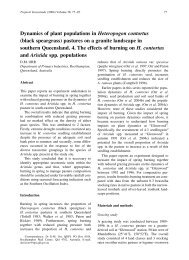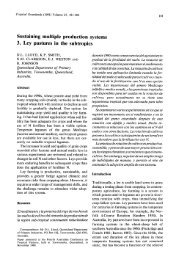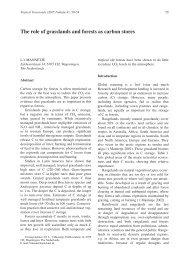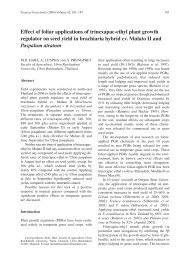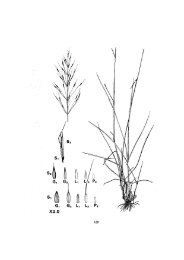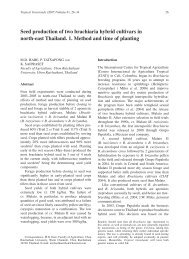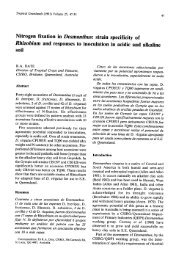Utilisation of ley legumes as livestock feed in Zimbabwe - Tropical ...
Utilisation of ley legumes as livestock feed in Zimbabwe - Tropical ...
Utilisation of ley legumes as livestock feed in Zimbabwe - Tropical ...
You also want an ePaper? Increase the reach of your titles
YUMPU automatically turns print PDFs into web optimized ePapers that Google loves.
86 C. Mapiye et al.<br />
be considered, <strong>in</strong>clud<strong>in</strong>g those developed for<br />
different environments <strong>in</strong> terms <strong>of</strong> soil, climate<br />
and production systems. In addition to a wider<br />
species range, evaluation <strong>of</strong> <strong>legumes</strong> should be<br />
b<strong>as</strong>ed on an <strong>in</strong>tra-specific variability <strong>as</strong> broad <strong>as</strong><br />
possible.<br />
Longevity <strong>of</strong> the species is another important<br />
consideration. Although the concept <strong>of</strong> a shortterm<br />
<strong>ley</strong> almost implies that the respective legume<br />
is short-lived, persistent legume banks or mixed<br />
p<strong>as</strong>tures with high legume content should also be<br />
considered. In comparison with annuals, longerlived<br />
<strong>legumes</strong> will have an important advantage<br />
dur<strong>in</strong>g the dry se<strong>as</strong>on. In this context, a potential<br />
option that should be researched is that <strong>of</strong> mixtures<br />
<strong>of</strong> complementary legume species. Possible<br />
topics for future research are <strong>as</strong> follows: characterisation<br />
<strong>of</strong> the potential <strong>of</strong> soil seed reserves<br />
and seedl<strong>in</strong>g recruitment; break<strong>in</strong>g <strong>of</strong> pest and<br />
dise<strong>as</strong>e cycles through legume <strong>ley</strong>s; and me<strong>as</strong>urement<br />
<strong>of</strong> animal production on legume <strong>ley</strong>s (very<br />
limited data currently available).<br />
Agronomy <strong>of</strong> <strong>ley</strong> <strong>legumes</strong><br />
Ley legume experiments were conducted to provide<br />
additional <strong>in</strong>formation on the management<br />
<strong>of</strong> new p<strong>as</strong>ture species that would have succeeded<br />
<strong>in</strong> evaluation trials. At Gr<strong>as</strong>slands, it w<strong>as</strong><br />
established that lablab, cowpea and velvet bean<br />
should be planted with the first ra<strong>in</strong>s <strong>in</strong> October–<br />
November <strong>in</strong> order to maximise herbage yield.<br />
Velvet bean, cowpea and lablab are best sown<br />
<strong>in</strong>to a well prepared, fallowed seedbed that h<strong>as</strong> a<br />
good depth <strong>of</strong> subsoil moisture (at le<strong>as</strong>t 60 cm).<br />
Seed should be sown at a depth <strong>of</strong> 5–10 cm <strong>in</strong>to<br />
moist soil with good seed-soil contact. For pure<br />
stands, the <strong>in</strong>ter-row and <strong>in</strong>tra-row spac<strong>in</strong>gs<br />
should range from 60–100 cm and 20–75 cm,<br />
respectively. The average seed<strong>in</strong>g rates for velvet<br />
bean, cowpea and lablab are 20–30, 10–20 and<br />
15–25 kg/ha, respectively. Normally, one seed<br />
per station is allowed, because the germ<strong>in</strong>ation<br />
rate is very good (75–95%) for seed, which h<strong>as</strong><br />
been less than 18 months <strong>in</strong> storage. These <strong>ley</strong><br />
<strong>legumes</strong> are <strong>in</strong>oculated with cowpea rhizobium,<br />
and lime is applied at a rate <strong>of</strong> 500–1000 kg/<br />
ha before plant<strong>in</strong>g. B<strong>as</strong>al applications <strong>of</strong> s<strong>in</strong>gle<br />
superphosphate at a rate <strong>of</strong> 150–300 kg/ha and<br />
pot<strong>as</strong>sium (K) <strong>as</strong> muriate <strong>of</strong> pot<strong>as</strong>h at a rate <strong>of</strong><br />
40–200 mg/kg before or at plant<strong>in</strong>g are recommended<br />
(Muchadeyi 1998). It w<strong>as</strong> also shown<br />
that it is best to harvest lablab once (May–June)<br />
for optimum herbage yield (Manyawu 1998).<br />
Results <strong>of</strong> <strong>in</strong>tercropp<strong>in</strong>g research over the p<strong>as</strong>t<br />
two decades favoured the simultaneous plant<strong>in</strong>g<br />
<strong>of</strong> <strong>ley</strong> <strong>legumes</strong> (velvet bean, cowpea and lablab)<br />
with maize, napier/bana gr<strong>as</strong>s, millet or sorghum,<br />
except where the legume can be too vigorous for<br />
the companion crop (Muchadeyi 1998; Nyoka<br />
et al. 2004). Intercropp<strong>in</strong>g with <strong>legumes</strong> <strong>in</strong>cre<strong>as</strong>ed<br />
herbage yield by 40–60%, although the cereal<br />
gra<strong>in</strong> yields were depressed by up to 20%. When<br />
velvet bean is mixed with gr<strong>as</strong>ses or cereals, the<br />
yield <strong>of</strong> cereals is naturally depressed to below<br />
10 t/ha. However, the total yields depend on plant<br />
populations, quality <strong>of</strong> the se<strong>as</strong>on and the management<br />
systems employed (Muza 1998). Lablab<br />
should be sown about 28 days after the maize<br />
crop h<strong>as</strong> been planted to avoid severe depression<br />
<strong>in</strong> cereal crop yield from competition. Where<br />
lablab precedes maize <strong>in</strong> a rotation, nitrogen fertiliser<br />
application can be reduced to 75% <strong>of</strong> the<br />
recommended levels <strong>in</strong> the subsequent maize<br />
crop (Muchadeyi 1998). In on-farm trials <strong>in</strong> the<br />
Hwedza communal area <strong>of</strong> <strong>Zimbabwe</strong>, varieties<br />
<strong>of</strong> velvet bean and lablab were found to improve<br />
the maize crop <strong>in</strong> the follow<strong>in</strong>g year by up to<br />
3 t/ha, compared with a ‘weed fallow’ before<br />
sow<strong>in</strong>g the maize (Jiri 2003). Future research on<br />
the economics (costs and benefits) <strong>of</strong> us<strong>in</strong>g <strong>ley</strong><br />
<strong>legumes</strong> is essential to allow farmers to make<br />
<strong>in</strong>formed decisions relat<strong>in</strong>g to <strong>in</strong>put costs and<br />
production benefits.<br />
Conservation and utilisation <strong>of</strong> <strong>ley</strong> <strong>legumes</strong><br />
Velvet bean<br />
Feed<strong>in</strong>g value. In <strong>Zimbabwe</strong>, velvet bean is used<br />
<strong>as</strong> green manure and for cattle <strong>feed</strong>, <strong>as</strong> mature<br />
pods, hay, ensilage with mol<strong>as</strong>ses, maize-Mucuna<br />
silage or graz<strong>in</strong>g (Jiri 2003). Dry matter (DM) production<br />
is high, reach<strong>in</strong>g 9–12 t/ha <strong>in</strong> a 900 mm<br />
ra<strong>in</strong>fall region <strong>in</strong> <strong>Zimbabwe</strong> (Muchadeyi 1998).<br />
Fresh velvet bean is <strong>of</strong> good quality (Table 2)<br />
with an average <strong>of</strong> 23% crude prote<strong>in</strong> (CP) and<br />
82% total digestible nutrients (TDN) (Topps and<br />
Oliver 1993; Muchadeyi 1998). Ma<strong>as</strong>dorp and Titterton<br />
(1997) reported CP concentration <strong>of</strong> 182 g/<br />
kg DM <strong>in</strong> Mucuna forage <strong>in</strong> <strong>Zimbabwe</strong> at peak<br />
biom<strong>as</strong>s yield (also peak digestible dry matter<br />
yield) at the early green pod stage. These results<br />
were comparable with those for lablab (164 g/kg)



